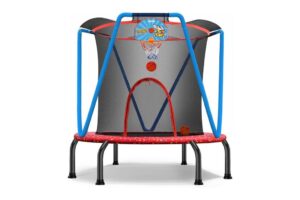Introduction
During today’s rapid pace of life, prioritizing one’s mental health has become increasingly crucial. While traditional methods like therapy and medication play crucial roles, there are also unconventional yet effective ways to boost your mood and alleviate stress. One such method gaining attention is trampolining. Yes, you read that right – bouncing on a trampoline can do wonders for your mental health and well-being. Here, we’ll explore how trampolines can positively impact your mood and overall mental health.
Before we delve into the mental health benefits, let’s briefly touch on the science behind trampolining. When you bounce on a trampoline, your body experiences a unique combination of gravitational forces, resulting in a rhythmic up-and-down motion. This motion engages various muscle groups, improves circulation, and stimulates the release of endorphins – the body’s natural mood elevators.
Endorphins are neurotransmitters produced by the central nervous system that act as natural painkillers and mood enhancers. Physical activities like trampolining trigger the release of endorphins, leading to feelings of euphoria and happiness. As a result, bouncing on a trampoline can help alleviate symptoms of stress, anxiety, and depression.
Trampolining offers a unique form of stress relief by providing a distraction from daily worries and responsibilities. When you’re bouncing on a trampoline, your mind becomes focused on the rhythmic motion and the sensation of weightlessness. This mindfulness-like state allows you to temporarily escape from stressors and achieve a sense of mental clarity, calmness and perfect mental health.
Another way trampolining contributes to better mental health is through improved sleep quality. Regular physical activity, such as bouncing on a trampoline, can help regulate sleep patterns and promote deeper, more restorative sleep. Adequate sleep is essential for maintaining emotional balance and cognitive function, making trampolining a valuable tool for enhancing overall well-being.
Trampolining is often a social activity, whether enjoyed with friends at a trampoline park or with family in the backyard. Social connection is vital for mental health, as it provides emotional support, reduces feelings of isolation, and fosters a sense of belonging. Bouncing on a trampoline with loved ones not only promotes physical health but also strengthens bonds and boosts mood through shared laughter and enjoyment.
Trampolines offer more than just a fun way to get some exercise – they also have significant benefits for mental health and well-being. From triggering the release of endorphins to providing stress relief and promoting social connection, bouncing on a trampoline can uplift your mood and contribute to a healthier mind. So, the next time you’re feeling stressed or down, consider taking a bounce on a trampoline – your mental health will thank you.
The Science of Bouncing
Trampolining isn’t just a fun activity; it’s a fascinating interplay of physics and physiology. As we bounce up and down on the trampoline surface, we’re not only experiencing moments of weightlessness and gravity’s pull but also triggering a cascade of physiological responses within our bodies. Here, let’s uncover the difficult science behind bouncing and explore how it influences our physical and mental health.
The Physics Behind Trampolining
When you take a leap onto a trampoline, you’re essentially engaging in a battle between gravitational forces and elastic resistance. The trampoline surface, typically made of a stretchy material like nylon or polypropylene, provides the necessary elasticity to push you upward when compressed. As you exert force downward with each bounce, the trampoline surface yields, storing potential energy. This stored energy then converts into kinetic energy, propelling you back into the air as the surface recoils.
But it’s not just about the bounce – it’s also about the rebound. As you descend, your body experiences a sudden increase in gravitational force, which compresses your muscles and joints. This compression triggers a stretch reflex, causing your muscles to contract rapidly to protect your body from impact. This reflexive contraction not only propels you back upward but also engages various muscle groups, from your legs and core to your arms and shoulders.
How Bouncing Affect the Body’s Chemistry
Beyond the mechanical aspects, trampolining also exerts a profound influence on your body’s chemistry, particularly in the realm of neurotransmitters. When you engage in physical activity, such as bouncing on a trampoline, your brain releases a flood of neurotransmitters, including dopamine, serotonin, and endorphins.
Dopamine, often referred to as the “feel-good” neurotransmitter, plays a central role in reward-motivated behavior and pleasure sensations. Serotonin, on the other hand, regulates mood, appetite, and sleep, contributing to feelings of well-being and happiness. And then there are the endorphins – the body’s natural painkillers and mood enhancers – which flood your system during intense physical exertion, producing feelings of euphoria and exhilaration.
In essence, trampolining acts as a catalyst for this neurochemical symphony, enhancing mood, reducing stress, and promoting overall well-being. By bouncing on a trampoline, you’re not just engaging in a fun activity; you’re also giving your body and mind a powerful boost of positivity.
Next, we’ll delve deeper into the role of endorphins in stress reduction and explore how trampolining can serve as a potent stress-relief tool. So, buckle up (or rather, bounce up), as we continue our journey into the fascinating world of trampoline science.
Endorphins and Stress Reduction
In the realm of stress reduction and mood enhancement, few substances hold as much sway as endorphins – the body’s own built-in stress busters and mood elevators. And when it comes to triggering the release of these feel-good neurotransmitters, few activities rival the effectiveness of trampolining. Here, let’s delve into the fascinating interplay between endorphins and bouncing and explore how trampolining serves as a potent antidote to stress and tension.
The Role of Endorphins in Mood Regulation
Endorphins, often dubbed the body’s natural painkillers, are a class of neurotransmitters produced by the central nervous system in response to various stimuli, including stress, pain, and physical exertion. These endogenous opioids bind to specialized receptors in the brain, triggering feelings of euphoria, pleasure, and well-being.
But endorphins aren’t just about dulling pain – they also play a crucial role in regulating mood and emotional states. By modulating neurotransmitter activity in key regions of the brain, such as the limbic system and prefrontal cortex, endorphins help buffer against stress, anxiety, and depression, supporting the development of a peaceful mindset and inner strength during challenges.
How Trampolining Stimulates Endorphin Release
So, how does trampolining factor into this endorphin equation? The answer lies in the unique combination of physical exertion, rhythmic motion, and sensory stimulation inherent in bouncing on a trampoline. When you engage in trampolining, whether it’s a series of gentle bounces or an exhilarating sequence of flips and twists, your body undergoes a cascade of physiological changes that trigger the release of endorphins.
As you bounce up and down on the trampoline surface, your muscles contract and stretch, sending signals to your brain to release endorphins in response to the physical stress and exertion. Additionally, the rhythmic motion and sensory feedback from the bouncing movement stimulate the production of endorphins, further amplifying their release.
The result? A surge of feel-good neurotransmitters flooding your system, washing away stress and tension, and leaving you with a sense of euphoria, good mental health and well-being. It’s no wonder that many trampoline enthusiasts report feeling uplifted and rejuvenated after a session of bouncing – they’re literally riding the wave of endorphin-induced bliss.
Next, we’ll explore how trampolining can serve as a mindfulness practice, offering a welcome respite from the pressures of daily life and promoting perfect mental health and relaxation. So, grab your bouncing shoes and join us as we continue our journey into the world of trampoline therapy.
Stress Relief and Mindfulness
In the chaotic of modern life, finding moments of tranquility and peace of mind can seem like a faraway dream. However, amidst the noise and distractions, there exists a simple yet powerful tool for stress relief and mindfulness – trampolining. Here, we’ll explore how bouncing on a trampoline can serve as a gateway to relaxation, offering a respite from the pressures of daily life and fostering a deeper sense of mindfulness and mental clarity.
Using Trampolining as a Stress Management Tool
When life’s demands become overwhelming, it’s essential to have effective strategies for managing stress and anxiety. While traditional methods like meditation and deep breathing exercises certainly have their merits, trampolining offers a dynamic alternative that engages both body and mind in a joyful, uplifting activity.
As you bounce on the trampoline surface, your focus shifts from worries and distractions to the rhythmic motion of the bounce. With each upward leap, you leave behind the stresses of the day, embracing the sensation of weightlessness and freedom. The repetitive nature of bouncing creates a soothing rhythm, calming the mind and promoting relaxation.
Moreover, the physical exertion involved in trampolining triggers the release of endorphins – the body’s natural mood elevators – further enhancing feelings of well-being and contentment. In this way, trampolining acts as a potent stress-relief tool, allowing you to release tension and rejuvenate both body and mind.
Achieving Mindfulness Through Bouncing
In addition to its stress-relieving properties, trampolining also offers a pathway to mindfulness – the practice of being fully present and aware in the moment. As you bounce on the trampoline, your attention becomes focused on the sensation of movement, the rhythm of your breath, and the feeling of air rushing past you.
In this state of focused attention, distractions fade away, and you enter a state of flow – a state of optimal experience where you’re fully immersed in the activity at hand. The repetitive nature of bouncing provides a meditative rhythm, guiding you into a state of deep relaxation and mental clarity.
Furthermore, the sensory feedback from the bouncing motion enhances your awareness of your body and its movements, promoting proprioception – the sense of where your body is in space. This heightened body awareness fosters a deeper connection between mind and body, allowing you to experience a profound sense of presence and inner peace.
In conclusion, trampolining offers more than just a fun way to get some exercises – it’s also a powerful tool for stress relief and mindfulness. By bouncing on a trampoline, you can release tension, cultivate a sense of calmness, and reconnect with the present moment. So, the next time you’re feeling overwhelmed or stressed, consider taking a bounce on a trampoline – your body and mind will thank you.
Improved Sleep Quality
In today’s fast-paced world, quality sleep has become a precious commodity, often eluding many of us amidst the chaos of daily life. Yet, amidst the quest for the perfect mattress and the latest sleep gadgets, there exists a simple yet effective solution for achieving better sleep – trampolining. Here, we’ll explore how bouncing on a trampoline can lead to improved sleep quality and more restful nights.
The Relationship Between Physical Activity and Sleep
It’s no secret that regular physical activity is linked to better sleep quality. Engaging in exercises helps regulate our internal body clock, known as the circadian rhythm, which governs our sleep-wake cycle. By exposing ourselves to natural light during the day and engaging in physical activity, we signal to our bodies that it’s time to be awake and alert. As the day winds down and evening approaches, our bodies naturally transition into a state of relaxation in preparation for sleep.
However, not all forms of exercise are created equal when it comes to sleep. While high-intensity workouts close to bedtime may leave you feeling wired and restless, gentler forms of exercise, such as yoga or walking, can promote relaxation and help prepare your body for sleep. Trampolining falls into this latter category, offering a low-impact yet effective way to get your heart pumping and your body moving without overstimulating your nervous system.
How Trampolining Enhances Sleep Quality
So, how does bouncing on a trampoline translate into better sleep? The answer lies in the unique combination of physical exertion, stress relief, and endorphin release that trampolining provides. When you bounce on a trampoline, you engage multiple muscle groups, get your blood flowing, and stimulate the release of endorphins – the body’s natural mood elevators.
This trifecta of physical activity, stress reduction, and endorphin release sets the stage for a restorative night’s sleep. The physical exertion tires out your body, making it more likely to crave rest and relaxation. The stress-relieving properties of trampolining help calm your mind and unwind after a busy day, while the endorphins flood your system with feelings of happiness and contentment, setting the stage for a peaceful slumber.
Furthermore, trampolining can help regulate your body’s internal clock by exposing you to natural light and fresh air, especially if you bounce outdoors. This exposure helps reinforce your circadian rhythm, making it easier to fall asleep at night and wake up feeling refreshed in the morning.
In conclusion, trampolining offers a fun and effective way to improve sleep quality, renew our mental health and enhance overall well-being. By incorporating bouncing into your daily routine, you can reap the benefits of better sleep, increased energy levels, and improved mood. So, the next time you’re struggling to get some shut-eye, consider taking a bounce on a trampoline – your body and mental health will thank you for it.
Social Connection and Support
In a world where screens often dominate our interactions, finding meaningful ways to connect with others has never been more important. Trampolining offers a unique opportunity to break free from the digital distractions and engage in joyful, physical activity with friends and family. Here, we’ll explore how bouncing on a trampoline fosters social connection and support, enriching relationships and creating lasting memories.
The Importance of Social Interaction for Mental Health
Research has shown that social connection plays a crucial role in our mental and emotional well-being. Strong social ties have been linked to lower rates of anxiety and depression, increased resilience to stress, and improved overall quality of life. By spending time with friends and loved ones, we experience a sense of belonging, acceptance, and support that nurtures our sense of self-worth and fulfillment.
Unfortunately, in today’s fast-paced world, meaningful social interactions can sometimes take a backseat to the demands of work, school, and other obligations. That’s where trampolining comes in – it offers a fun and engaging way to reconnect with others and strengthen bonds in a relaxed and enjoyable environment.
Building Relationships Through Trampoline Activities
Whether you’re bouncing with friends at a trampoline park or enjoying a backyard bounce session with your family, trampolining provides the perfect setting for bonding and camaraderie. As you leap and laugh together, you’ll create shared memories and inside jokes that will be cherished for years to come.
Trampoline activities also encourage teamwork and cooperation, as you coordinate your movements to perform synchronized jumps or playful games. From friendly competitions to collaborative routines, trampolining offers endless opportunities for creative expression and shared experiences.
Moreover, bouncing on a trampoline can break down social barriers and facilitate communication, making it easier to connect with others on a deeper level. The carefree atmosphere of the trampoline park encourages spontaneity and laughter, helping to forge genuine connections and foster a sense of community among participants.
Supporting Each Other’s Wellness Journey
In addition to strengthening existing relationships, trampolining can also be a catalyst for forming new friendships and support networks. Whether you’re bonding over a shared love of bouncing or offering encouragement to a newcomer, trampoline activities provide a supportive and inclusive environment where everyone can feel welcome and valued.
By bouncing together, we not only improve our physical health but also nurture our mental health and emotional well-being. So, the next time you’re looking for a fun and meaningful way to connect with others, consider inviting them to join you for a bounce on the trampoline. You’ll not only have a blast together but also strengthen your bonds and create lasting memories that will uplift your spirits for years to come.
Conclusion
As we come to the end of our exploration into the world of trampolines and their impact on mental health, it’s clear that bouncing offers far more than just a fun way to get some exercise. From triggering the release of endorphins to promoting stress relief, mindfulness, and social connection, trampolining has emerged as a powerful tool for enhancing overall well-being and vitality of mental health.
Throughout this journey, we’ve delved into the science behind bouncing, uncovering the intricate interplay of physics, physiology, and neurochemistry that makes trampolining such a potent mood booster. We’ve explored how bouncing on a trampoline can lead to improved sleep quality, better stress management, and enhanced mental clarity, empowering us to face life’s challenges with resilience and optimism.
Moreover, we’ve celebrated the transformative power of trampolining in fostering social connection and support, bringing people together in joyful, shared experiences that strengthen bonds and enrich lives. Whether bouncing with friends, family, or even strangers at a trampoline park, we’ve witnessed the profound sense of camaraderie and belonging that arises when we leap and laugh together.
As we bid farewell to this journey, let us carry forward the lessons learned and the insights gained into our daily lives. Let us embrace the joy and vitality that trampolining offers, knowing that each bounce brings us closer to a brighter, healthier future.
So, the next time you’re feeling stressed, tired, or disconnected, remember the simple joy of bouncing on a trampoline. Take a leap of faith, and let the rhythmic motion carry you to new heights of well-being and happiness. You will receive gratitude from your body, mind, and spirit for this. The coming days brimming with happiness, romance, and limitless jumps. Happy bouncing!
Related posts:
- Rebounding for Cardio Fitness: Unlock Heart Health Power
- Trampoline Safety Tips – Jumping for Joy without the Risk
- Trampoline Assembly Excellence: Your Comprehensive Step-by-Step Guide to Bouncing Bliss!
- Trampoline Hole Repair Guide: Masterful Fixes for Unleashing Bouncing Power!
- Indoor vs. Outdoor Trampolines: Dominate Your Bounce


























